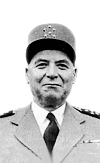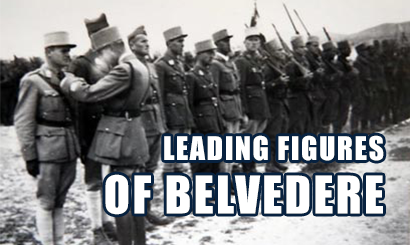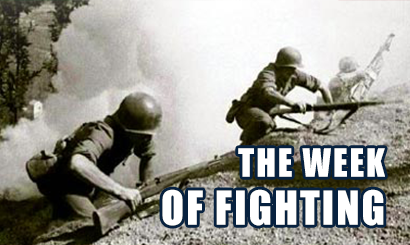 A great French figure of the Second World War, in 1944 Juin was Commander-in-Chief of the French Expeditionary Corps in Italy. (C.E.F. or C.E.F.I.). He entrusted the attack on the Belvedere massif to General Monsabert and stayed at his side during the week of fighting under the fir trees of hill 784, on the slopes of the left bank of the Rapido, where the 3rd D.I.A. had its H.Q.
A great French figure of the Second World War, in 1944 Juin was Commander-in-Chief of the French Expeditionary Corps in Italy. (C.E.F. or C.E.F.I.). He entrusted the attack on the Belvedere massif to General Monsabert and stayed at his side during the week of fighting under the fir trees of hill 784, on the slopes of the left bank of the Rapido, where the 3rd D.I.A. had its H.Q.
Alphonse Juin was born in Bône in Algeria on 16 December 1888. His father was a policeman at Mostaganem. He joined Saint-Cyr [Military Academy] in 1909, graduating top of his year in 1912, the same year as a certain Charles de Gaulle who came 13th. During the First World War, he took part in the Senlis, Ourcq and Aisne offensives in 1914, later fighting in the Battle of Soissons where he was wounded in the right arm. He took part in the ill-fated Chemin des Dames offensive in 1917.
After the First World War, he taught at the Ecole de Guerre (Military Academy), and later took part in various operations whose stated aim was to “pacify” Morocco. From 1931 he was principal private secretary to [Major General] Lyautey at Rabat. He was rapidly promoted to Chief of Staff of the armed forces in North Africa.
In 1940, he was at the head of the 15th Motorised Infantry Division (D.I.M.). He won the Battle of Gembloux in Belgium with the 1st Moroccan Division on 14 and 15 May 1940. After the collapse of the Meuse front, he took part in the Battle of Lille where he was taken prisoner on 29 May 1940.
He was freed in June 1941 at the request of Vichy. He was then appointed Commander-in-Chief of the North African troops on 20 November 1941 and placed under the direct authority of Admiral Darlan. He met Goering in Berlin on 21 December 1941, which was widely held against him by his detractors. Juin later declared that he was playing a double game with the Germans and that his intention was to secretly pursue Weygand’s efforts to strengthen the French army in North Africa.
When the Americans landed in Algeria and Morocco (operation Torch of 8 November 1942), he made the so-called “gallant last stand”, then joined the Allies. After the assassination of Darlan, Juin was placed under the command of General Giraud, who put him in charge of the French forces in the Tunisian campaign.
In 1943 the Americans put him in charge of the C.E.F. under the command of Alexander and Clark.
He commanded all the French military operations during the Italian campaign with brilliance, and as such, Juin has an undisputed place in history as the architect of the French army’s return to favour with the Allies. It was Juin who directed the assaults on the Belvedere with Monsabert at his side. Alexander and Clark both wrote him particularly complimentary letters at the end of the Italian campaign.
He wrote his memoirs of the C.E.F. in “La Campagne d’Italie” that was published in 1962.
In 1952, he was promoted to the rank of Marshal of France and elected a member of the Académie Française (prestigious French learned society). Like most soldiers of that era, he quarrelled with de Gaulle over Algeria. He died in 1967.



